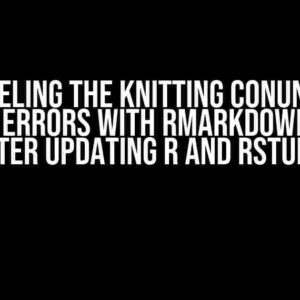Are you tired of pulling your hair out, trying to figure out why the MudTextField value refuses to update in your Blazor Server app? Fear not, dear developer, for you’re not alone! In this comprehensive guide, we’ll embark on a quest to unravel the mystery behind the non-updating MudTextField bind value and provide you with concrete solutions to overcome this hurdle.
What’s the Deal with MudBlazor and Blazor Server?
MudBlazor, a popular Material Design component library for Blazor, offers a rich set of UI components, including the MudTextField. Blazor Server, on the other hand, is a framework for building server-side web applications using C# and Razor templates. When you combine these two, you’d expect a seamless user experience. However, sometimes the MudTextField bind value can be stubborn and refuse to update.
The Problem: MudTextField Bind Value Not Updating
Imagine you have a simple form with a MudTextField, like so:
<MudTextField @bind-Value="myValue" />where `myValue` is a string property in your component:
@code {
private string myValue { get; set; }
}When you enter a new value in the MudTextField, you’d expect the `myValue` property to update automatically. But, alas! The value remains stuck, leaving you scratching your head.
The Culprits: Common Causes of the Issue
Before we dive into the solutions, let’s investigate the common culprits behind this problem:
- Property Notified incorrectly: Are you using the correct property notification mechanism?
- MudTextField Configuration: Have you misconfigured the MudTextField?
- Blazor Server Lifecycles: Are you aware of the Blazor Server’s lifecycle events and how they impact your component?
- Data Binding Gotchas: Are you falling victim to common data binding pitfalls?
Solution 1: Verify Property Notification
In Blazor, property notification is crucial for data binding to work correctly. Ensure you’re using the correct notification mechanism:
@code {
private string myValue { get; set; }
private void OnPropertyChanged([CallerMemberName] string propertyName = null)
{
StateHasChanged();
}
}Alternatively, you can use the `INotifyPropertyChanged` interface:
@code {
private string myValue { get; set; }
public event PropertyChangedEventHandler PropertyChanged;
protected virtual void OnPropertyChanged([CallerMemberName] string propertyName = null)
{
PropertyChanged?.Invoke(this, new PropertyChangedEventArgs(propertyName));
}
}Solution 2: Configure MudTextField Correctly
Double-check your MudTextField configuration:
<MudTextField @bind-Value="myValue" Immediate="true" />The `Immediate` property should be set to `true` to ensure the value is updated immediately.
Solution 3: Understand Blazor Server Lifecycles
Blazor Server’s lifecycle events can impact your component’s behavior. Make sure you understand how the following events affect your component:
- OnInitializedAsync: Called when the component is initialized.
- OnParametersSetAsync: Called when the component’s parameters are set.
- OnAfterRenderAsync: Called after the component has finished rendering.
Use these events judiciously to update your component’s state correctly.
Solution 4: Avoid Data Binding Gotchas
Be mindful of common data binding pitfalls:
- Use `@bind` instead of `@onchange`: `@bind` is the recommended way for two-way data binding.
- Avoid using `async` methods for data binding: `async` methods can cause data binding issues.
- Don’t update the bound property directly: Instead, use a separate property or a view model to update the value.
Putting it All Together
Let’s create a simple example that demonstrates the correct usage of MudTextField and Blazor Server:
<MudTextField @bind-Value="myValue" Immediate="true" />
@code {
private string myValue { get; set; }
private void OnPropertyChanged([CallerMemberName] string propertyName = null)
{
StateHasChanged();
}
}In this example, we’ve used the correct property notification mechanism, configured the MudTextField correctly, and ensured that the Blazor Server lifecycle events don’t interfere with our component’s state.
Conclusion
Troubleshooting the MudTextField bind value not updating issue in Blazor Server can be a challenge, but by following these solutions, you’ll be well on your way to resolving this problem. Remember to:
- Verify property notification
- Configure MudTextField correctly
- Understand Blazor Server lifecycles
- Avoid data binding gotchas
With these solutions, you’ll be able to create seamless user experiences with MudBlazor and Blazor Server. Happy coding!
| Solution | Description |
|---|---|
| 1. Verify Property Notification | Use correct property notification mechanism |
| 2. Configure MudTextField Correctly | Set `Immediate` property to `true` |
| 3. Understand Blazor Server Lifecycles | Aware of OnInitializedAsync, OnParametersSetAsync, and OnAfterRenderAsync events |
| 4. Avoid Data Binding Gotchas | Avoid common data binding pitfalls |
Remember, by following these solutions, you’ll be able to overcome the MudTextField bind value not updating issue and create a seamless user experience with MudBlazor and Blazor Server.
Frequently Asked Question
Get the answers to the most commonly asked questions about Blazor Server, MudBlazor, and MudTextField bind value not updating.
Why is my MudTextField bind value not updating in Blazor Server?
This is likely due to the fact that Blazor Server uses a complex rendering mechanism, which can sometimes cause binding issues. Make sure you’re using the correct binding syntax and that your component is properly updated in the UI.
How can I force an update of the MudTextField value in Blazor Server?
You can try calling `StateHasChanged()` after updating the bound value. This will force the component to re-render and update the UI. However, be careful not to abuse this method, as it can lead to performance issues.
Is there a way to debug binding issues in Blazor Server with MudBlazor?
Yes, you can use the built-in debugging tools in Visual Studio or Chrome DevTools to inspect the component’s state and bindings. You can also use the `@debug` directive to print debug information to the console.
Can I use a two-way binding with MudTextField in Blazor Server?
Yes, MudBlazor supports two-way binding with MudTextField. Simply use the `@bind` syntax to bind the value to a property, and the component will automatically update the value when the user inputs a new value.
What are some common pitfalls to avoid when using MudTextField with Blazor Server?
Some common pitfalls include not using the correct binding syntax, not updating the component’s state correctly, and abusing the `StateHasChanged()` method. Additionally, make sure to check the MudBlazor documentation for any specific requirements or limitations when using MudTextField with Blazor Server.




